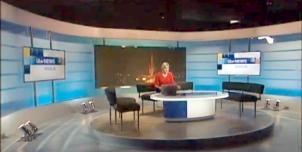Full Freeview on the Sandy Heath (Central Bedfordshire, England) transmitter
| Google Streetview | Google map | Bing map | Google Earth | 52.130,-0.242 or 52°7'47"N 0°14'33"W | SG19 2NH |
The symbol shows the location of the Sandy Heath (Central Bedfordshire, England) transmitter which serves 920,000 homes. The bright green areas shown where the signal from this transmitter is strong, dark green areas are poorer signals. Those parts shown in yellow may have interference on the same frequency from other masts.
_______
Digital television services are broadcast on a multiplexes (or Mux) where many stations occupy a single broadcast frequency, as shown below.
64QAM 8K 3/4 27.1Mb/s DVB-T MPEG2
H/V: aerial position (horizontal or vertical)
Which Freeview channels does the Sandy Heath transmitter broadcast?
If you have any kind of Freeview fault, follow this Freeview reset procedure first.Digital television services are broadcast on a multiplexes (or Mux) where many stations occupy a single broadcast frequency, as shown below.
64QAM 8K 3/4 27.1Mb/s DVB-T MPEG2
H/V: aerial position (horizontal or vertical)
Which BBC and ITV regional news can I watch from the Sandy Heath transmitter?

BBC Look East (West) 1.0m homes 3.7%
from Cambridge CB4 0WZ, 29km east-northeast (65°)
to BBC Cambridge region - 4 masts.
70% of BBC East (East) and BBC East (West) is shared output

ITV Anglia News 1.0m homes 3.7%
from Norwich NR1 3JG, 119km east-northeast (60°)
to ITV Anglia (West) region - 5 masts.
All of lunch, weekend and 80% evening news is shared with Anglia (East)
How will the Sandy Heath (Central Bedfordshire, England) transmission frequencies change over time?
| 1965-80s | 1984-97 | 1997-98 | 1998-2011 | 2011-13 | 12 Feb 2020 | ||||
| VHF | A K T | K T | K T | W T | W T | ||||
| C6 | ITVwaves | ||||||||
| C21 | C4waves | C4waves | C4waves | +BBCB | BBCB | ||||
| C24 | ITVwaves | ITVwaves | ITVwaves | D3+4 | D3+4 | ||||
| C27 | BBC2waves | BBC2waves | BBC2waves | BBCA | BBCA | ||||
| C31 | BBC1waves | BBC1waves | BBC1waves | ||||||
| C32 | com7 | ||||||||
| C33 | SDN | ||||||||
| C34 | com8 | ||||||||
| C35 | _local | ||||||||
| C36 | ArqA | ||||||||
| C39 | C5waves | C5waves | |||||||
| C43 | _local | ||||||||
| C48 | ArqB | ArqB | |||||||
| C51tv_off | SDN | ||||||||
| C52tv_off | ArqA | ||||||||
| C55tv_off | com7tv_off | ||||||||
| C56tv_off | COM8tv_off |
tv_off Being removed from Freeview (for 5G use) after November 2020 / June 2022 - more
Table shows multiplexes names see this article;
green background for transmission frequencies
Notes: + and - denote 166kHz offset; aerial group are shown as A B C/D E K W T
waves denotes analogue; digital switchover was 30 Mar 11 and 13 Apr 11.
How do the old analogue and currrent digital signal levels compare?
| Analogue 1-4 | 1000kW | |
| BBCA, D3+4, BBCB | (-7.4dB) 180kW | |
| SDN, ARQA, ARQB | (-7.7dB) 170kW | |
| com7 | (-13dB) 49.6kW | |
| com8 | (-13.1dB) 49.1kW | |
| Mux 1*, Mux 2*, Mux A*, Mux B*, Mux C*, Mux D* | (-17dB) 20kW | |
| Analogue 5 | (-20dB) 10kW |
Which companies have run the Channel 3 services in the Sandy Heath transmitter area
|
|
Saturday, 2 July 2011
S
Steve10:11 AM
IP27 is too vague but according to this
UK digital TV reception predictor
you do not even GET C67!
But 27dBuV/m is a weak signal and 67 end of frequency range. Rain may affect reflected signals
Digital has a "cliff" from good to useless, not a fine gradation.
| link to this comment |
Tuesday, 5 July 2011
B
Brian8:49 PM
I currently have an old 12 element wide band areal, whilst i noticed all around me have been having hi-gain [contract range] areals i don't feel this is necessary, as i can pick up many channels without connecting the areal, I am therefore considering replacing it with a Log-Periodic Aerial [short 28e]
do any of you technical wiz kids have a view on my decision
thanks
| link to this comment |
M
Mike Dimmick11:40 PM
Brian: If the old aerial works, I wouldn't replace it. Going by Justin Smith's aerial tests at Gain (curves), Again , a small log periodic (shown there as 'DM Log') should have more gain in Group A, for the PSB multiplexes, but will have less above C48, where the commercial multiplexes live.
The log periodic is supposedly more resilient to impulse interference, though, so if you find your reception breaks up when cars go past, it may help.
| link to this comment |
M
Mike Dimmick11:57 PM
Steve: DO NOT USE WOLFBANE. It is inaccurate, signal strengths shown are far lower than calculated by the ITU-R line-of-sight equation for known line-of-sight paths. I use Field Strength Calculator which shows a field strength of 81.3 dBuV/m at 66km from a 20kW transmitter on C67. Multiply the field strength shown in V/m by one million, take the base 10 logarithm ['log' on most calculators, not 'ln'] then multiply by 20.
We need a full postcode to see whether there is anything preventing line-of-sight. The Digital UK postcode checker considers how signals travel over the terrain and has factors for buildings and trees.
Bob Archer: If channels on higher frequencies break up when it rains, it often indicates that water is getting into the cables. Check that the seals on any outdoor boxes (such as a masthead amplifier or splitter) are intact and not letting water penetrate. Some aerials have a connection box on the aerial itself, where the cable connects to the aerial, again this needs to be watertight. If the cable has been up for a long time (over 10 years), the outer insulation may have perished due to ultraviolet light exposure and that again allows water to penetrate into the cable.
| link to this comment |
Friday, 8 July 2011
B
Brian8:31 PM
Hi mike thanks for the reply, having taken a close look at the old aerial, i noticed both the bracket and mast are suffering badly with corrosion so to save the hassle i think i will replace the lot, but following your advise i will just use a basic wide band [probably yegar pattern] aerial. for the time being i have plugged an old 8inch indoor loop to the decoder [got the wife off my back] and have perfect picture on most channels [a few are missing]
Many thanks for your imput
Brian
| link to this comment |
S
Steve P11:46 PM
Mike D - I do not believe Wolfbane's ae choices - I can at home get a signal with a set top loop where they say "amplified high gain"
But they have a very clear presentation of what might be available and relative strength; bearing, etc.
| link to this comment |
Sunday, 10 July 2011
C
chris4:08 PM
bran having problem picking up channels up on frequency 24, reads str 7 quailty 4, but it isn't on my frequency detected list ???
| link to this comment |
J
jb385:15 PM
chris: The answer totally depends on where you are located and what your aerial set up might be, with neither being mentioned!
Ch24 being the high powered PSB2 Mux on the Sandy (Anglia) transmitter.
| link to this comment |
C
chris9:07 PM
Cambridge
i have a wide band aerial, situated at roof height plus. am located in cb25 0bb admittingly itv never has been the best where i am, i have a hill between us and sandy and the sudbury tx the other way. the fact is that sandy my nearest has always been dedicated to bbc. have a feeling my box is up the creek, i will try another box on there
| link to this comment |
chris's: mapC's Freeview map terrainC's terrain plot wavesC's frequency data C's Freeview Detailed Coverage
Friday, 15 July 2011
J
Joe3:18 PM
hi I live in harlow ( cm187pb) and we are currently receiving our signal from sandy heath, a few weeks we lost mux: COM6 ArqB and from about 3 days ago we lost Mux: A..
nothing has changed with our set up, we are running 4 TV sets (3boxes 1freeview TV) from our outdoor ariel connected to. 4 way signal booster.
is it possible that our signal booster is boosting the week signals making them weeker? the problem with that is Mux C works perfectly, full signal. & no breakups.
any help/advice?
| link to this comment |
Select more comments
Your comment please!




